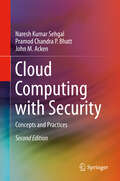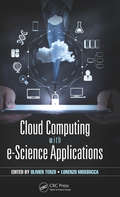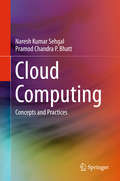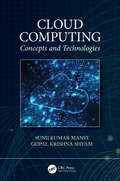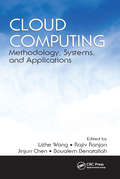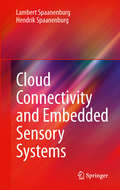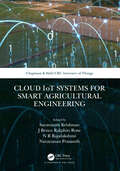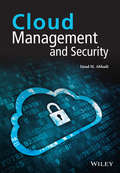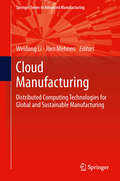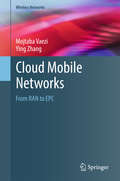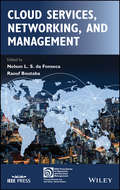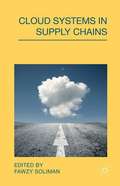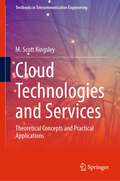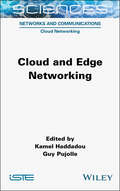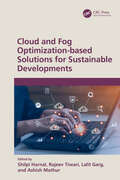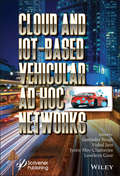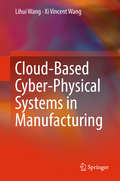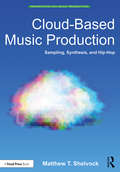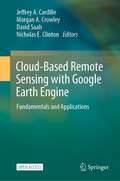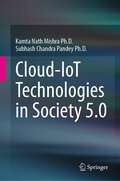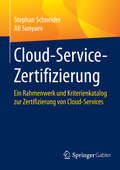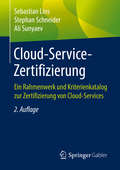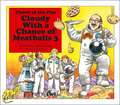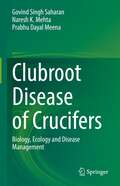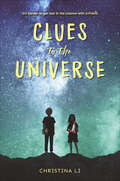- Table View
- List View
Cloud Computing with Security: Concepts and Practices
by Naresh Kumar Sehgal Pramod Chandra Bhatt John M. AckenThis book provides readers with an overview of Cloud Computing, starting with historical background on mainframe computers and early networking protocols, leading to current concerns such as hardware and systems security, performance, emerging areas of IoT, Edge Computing etc. Readers will benefit from the in-depth discussion of cloud computing usage and the underlying architectures. The authors explain carefully the “why’s and how’s” of Cloud Computing, so engineers will find this book an invaluable source of information to the topic. This second edition includes new material on Cloud Computing Security, Threat Vectors and Trust Models, as well as best practices for a using dynamic cloud infrastructure, and cloud operations management. Several new examples and analysis of cloud security have been added, including edge computing with IoT devices.
Cloud Computing with e-Science Applications
by Olivier Terzo Lorenzo MossuccaThe amount of data in everyday life has been exploding. This data increase has been especially significant in scientific fields, where substantial amounts of data must be captured, communicated, aggregated, stored, and analyzed. Cloud Computing with e-Science Applications explains how cloud computing can improve data management in data-heavy fields such as bioinformatics, earth science, and computer science. The book begins with an overview of cloud models supplied by the National Institute of Standards and Technology (NIST), and then: Discusses the challenges imposed by big data on scientific data infrastructures, including security and trust issues Covers vulnerabilities such as data theft or loss, privacy concerns, infected applications, threats in virtualization, and cross-virtual machine attack Describes the implementation of workflows in clouds, proposing an architecture composed of two layers—platform and application Details infrastructure-as-a-service (IaaS), platform-as-a-service (PaaS), and software-as-a-service (SaaS) solutions based on public, private, and hybrid cloud computing models Demonstrates how cloud computing aids in resource control, vertical and horizontal scalability, interoperability, and adaptive scheduling Featuring significant contributions from research centers, universities, and industries worldwide, Cloud Computing with e-Science Applications presents innovative cloud migration methodologies applicable to a variety of fields where large data sets are produced. The book provides the scientific community with an essential reference for moving applications to the cloud.
Cloud Computing: Concepts And Practices
by Naresh Kumar Sehgal Pramod Chandra P. BhattThis book provides readers with an overview of Cloud Computing, starting with historical background on mainframe computers and early networking protocols, leading to current concerns such as hardware and systems security, performance, emerging areas of IoT, Edge Computing etc. Readers will benefit from the in-depth discussion of cloud computing usage and the underlying architecture, with focus on best practices for using a dynamic cloud infrastructure, cloud operations management and cloud security. The authors explain carefully the “why’s and how’s” of Cloud Computing, so engineers will find this book and invaluable introduction to the topic.
Cloud Computing: Concepts and Technologies
by Sunilkumar Manvi Gopal ShyamComprehensive and timely, Cloud Computing: Concepts and Technologies offers a thorough and detailed description of cloud computing concepts, architectures, and technologies, along with guidance on the best ways to understand and implement them. It covers the multi-core architectures, distributed and parallel computing models, virtualization, cloud developments, workload and Service-Level-Agreements (SLA) in cloud, workload management. Further, resource management issues in cloud with regard to resource provisioning, resource allocation, resource mapping and resource adaptation, ethical, non-ethical and security issues in cloud are followed by discussion of open challenges and future directions. This book gives students a comprehensive overview of the latest technologies and guidance on cloud computing, and is ideal for those studying the subject in specific modules or advanced courses. It is designed in twelve chapters followed by laboratory setups and experiments. Each chapter has multiple choice questions with answers, as well as review questions and critical thinking questions. The chapters are practically-focused, meaning that the information will also be relevant and useful for professionals wanting an overview of the topic.
Cloud Computing: Methodology, Systems, and Applications (Computing And Networks Ser.)
by Lizhe Wang, Rajiv Ranjan, Jinjun Chen and Boualem BenatallahCloud computing has created a shift from the use of physical hardware and locally managed software-enabled platforms to that of virtualized cloud-hosted services. Cloud assembles large networks of virtual services, including hardware (CPU, storage, and network) and software resources (databases, message queuing systems, monitoring systems, and load-balancers). As Cloud continues to revolutionize applications in academia, industry, government, and many other fields, the transition to this efficient and flexible platform presents serious challenges at both theoretical and practical levels—ones that will often require new approaches and practices in all areas. Comprehensive and timely, Cloud Computing: Methodology, Systems, and Applications summarizes progress in state-of-the-art research and offers step-by-step instruction on how to implement it. Summarizes Cloud Developments, Identifies Research Challenges, and Outlines Future Directions Ideal for a broad audience that includes researchers, engineers, IT professionals, and graduate students, this book is designed in three sections: Fundamentals of Cloud Computing: Concept, Methodology, and Overview Cloud Computing Functionalities and Provisioning Case Studies, Applications, and Future Directions It addresses the obvious technical aspects of using Cloud but goes beyond, exploring the cultural/social and regulatory/legal challenges that are quickly coming to the forefront of discussion. Properly applied as part of an overall IT strategy, Cloud can help small and medium business enterprises (SMEs) and governments in optimizing expenditure on application-hosting infrastructure. This material outlines a strategy for using Cloud to exploit opportunities in areas including, but not limited to, government, research, business, high-performance computing, web hosting, social networking, and multimedia. With contributions from a host of internationally recognized researchers, this reference delves into everything from necessary changes in users’ initial mindset to actual physical requirements for the successful integration of Cloud into existing in-house infrastructure. Using case studies throughout to reinforce concepts, this book also addresses recent advances and future directions in methodologies, taxonomies, IaaS/SaaS, data management and processing, programming models, and applications.
Cloud Connectivity and Embedded Sensory Systems
by Hendrik Spaanenburg Lambert SpaanenburgSensor networks are meant to create awareness in space and time. They may be measuring the presence of an object or a condition, characterizing an object stream or a situational pattern, or even detect abnormalities that are to occur. This book provides new theory on the design of wireless sensor networks, based on concepts developed for large-scale, distributed computing environments known as "cloud computing." It provides a single-source entry into the world of intelligent sensory networks, with a step-by-step discussion of building case studies that capture the requirements, taking into account practical limitations of creating ambient intelligence. The reader will not only achieve a better understanding of sensory clouds, swarms and flocks but is also guided by examples of how to design such networks taking the typical characteristics of diverse application areas into account.
Cloud IoT Systems for Smart Agricultural Engineering (Chapman & Hall/CRC Internet of Things)
by Saravanan KrishnanAgriculture plays a vital role in a country’s growth. Modern-day technologies drive every domain toward smart systems. The use of traditional agricultural procedures to satisfy modern-day requirements is a challenging task. Cloud IoT Systems for Smart Agricultural Engineering provides substantial coverage of various challenges of the agriculture domain through modern technologies such as the Internet of Things (IoT), cloud computing, and many more. This book offers various state-of-the-art procedures to be deployed in a wide range of agricultural activities. The concepts are discussed with the necessary implementations and clear examples. Necessary illustrations are depicted in the chapters to ensure the effective delivery of the proposed concepts. It presents the rapid advancement of the technologies in the existing agricultural model by applying the cloud IoT techniques. A wide variety of novel architectural solutions are discussed in various chapters of this book. This book provides comprehensive coverage of the most essential topics, including: New approaches on urban and vertical farming Smart crop management for Indian farmers Smart livestock management Precision agriculture using geographical information systems Machine learning techniques combined with IoT for smart agriculture Effective use of drones in smart agriculture This book provides solutions for the diverse domain of problems in agricultural engineering. It can be used at the basic and intermediary levels for agricultural science and engineering graduate students, researchers, and practitioners.
Cloud Management and Security
by Imad M. AbbadiWritten by an expert with over 15 years’ experience in the field, this book establishes the foundations of Cloud computing, building an in-depth and diverse understanding of the technologies behind Cloud computing. In this book, the author begins with an introduction to Cloud computing, presenting fundamental concepts such as analyzing Cloud definitions, Cloud evolution, Cloud services, Cloud deployment types and highlighting the main challenges. Following on from the introduction, the book is divided into three parts: Cloud management, Cloud security, and practical examples. Part one presents the main components constituting the Cloud and federated Cloud infrastructure (e.g., interactions and deployment), discusses management platforms (resources and services), identifies and analyzes the main properties of the Cloud infrastructure, and presents Cloud automated management services: virtual and application resource management services. Part two analyzes the problem of establishing trustworthy Cloud, discusses foundation frameworks for addressing this problem – focusing on mechanisms for treating the security challenges, discusses foundation frameworks and mechanisms for remote attestation in Cloud and establishing Cloud trust anchors, and lastly provides a framework for establishing a trustworthy provenance system and describes its importance in addressing major security challenges such as forensic investigation, mitigating insider threats and operation management assurance. Finally, part three, based on practical examples, presents real-life commercial and open source examples of some of the concepts discussed, and includes a real-life case study to reinforce learning – especially focusing on Cloud security. Key Features • Covers in detail two main aspects of Cloud computing: Cloud management and Cloud security • Presents a high-level view (i.e., architecture framework) for Clouds and federated Clouds which is useful for professionals, decision makers, and students • Includes illustrations and real-life deployment scenarios to bridge the gap between theory and practice • Extracts, defines, and analyzes the desired properties and management services of Cloud computing and its associated challenges and disadvantages • Analyzes the risks associated with Cloud services and deployment types and what could be done to address the risk for establishing trustworthy Cloud computing • Provides a research roadmap to establish next-generation trustworthy Cloud computing • Includes exercises and solutions to problems as well as PowerPoint slides for instructors
Cloud Manufacturing: Distributed Computing Technologies for Global and Sustainable Manufacturing (Springer Series in Advanced Manufacturing)
by Weidong Li Jörn MehnenGlobal networks, which are the primary pillars of the modern manufacturing industry and supply chains, can only cope with the new challenges, requirements and demands when supported by new computing and Internet-based technologies. Cloud Manufacturing: Distributed Computing Technologies for Global and Sustainable Manufacturing introduces a new paradigm for scalable service-oriented sustainable and globally distributed manufacturing systems. The eleven chapters in this book provide an updated overview of the latest technological development and applications in relevant research areas. Following an introduction to the essential features of Cloud Computing, chapters cover a range of methods and applications such as the factors that actually affect adoption of the Cloud Computing technology in manufacturing companies and new geometrical simplification method to stream 3-Dimensional design and manufacturing data via the Internet. This is further supported case studies and real life data for Waste Electrical and Electronic Equipment (WEEE) remanufacturing. This compilation of up to date research and literature can be used as a textbook or reference for mechanical, manufacturing, and computer engineering graduate students and researchers for efficient utilization, deployment and development of distributed and Cloud manufacturing systems, services and applications.
Cloud Mobile Networks: From RAN to EPC (Wireless Networks)
by Ying Zhang Mojtaba VaeziThis book explores the challenges and opportunities in exploiting cloud technologies for 5G, ranging from radio access network (RAN) to the evolved packet core (EPC). With a specific focus on cloud RAN and EPC, the text carefully explains the influence of recent network technologies such as software defined networking (SDN), visualization, and cloud technologies in the evolution of architecture for future mobile networks. The book discusses the causes, benefits and challenges of cloud RAN and its interplay with other evolving technologies for future mobile networks. Researchers and professionals involved in mobile technology or cloud computing will find this book a valuable resource. The text is also suitable for advanced-level students studying all types of networking.
Cloud Services, Networking, and Management
by Nelson L. da Fonseca Raouf BoutabaCloud Services, Networking and Management provides a comprehensive overview of the cloud infrastructure and services, as well as their underlying management mechanisms, including data center virtualization and networking, cloud security and reliability, big data analytics, scientific and commercial applications. Special features of the book include: State-of-the-art content Self-contained chapters for readers with specific interests Includes commercial applications on Cloud (video services and games)
Cloud Systems in Supply Chains
by Alan Brown Mark Thompson Jerry FishendenCloud Systems in Supply Chains explores the risks that could face supply chain firms if their implementation of cloud systems is not carefully managed or if not appropriately selected and supported. This volume aids supply chain firms in ensuring that their cloud system activities are positioned to assist and sustain their competitive advantages.
Cloud Technologies and Services: Theoretical Concepts and Practical Applications (Textbooks in Telecommunication Engineering)
by M. Scott KingsleyThis textbook provides a thorough yet compact review of cloud technologies. It offers easy to understand explanations of the technical concepts underlying cloud services, platforms, and applications offered by Amazon Web Services (AWS), Microsoft Azure, and the Google Cloud Platform (GCP). It presents cloud concepts at a depth that can be understood and applied by both technical and non-technical readers. Once that is accomplished the learner can then easily move toward more advanced topics. Or, they can use the knowledge gained from this book to obtain industry certifications and be competitive in this exciting industry. Reader learning is enhanced with quizzes and exam questions and hands-on labs throughout the book with PowerPoint slides, instructor guide and additional labs online. All the tools needed for advancement to the level of cloud architect are found in this book. The author has verified the success of this approach in his own academic environment with much success. He teaches Cloud Engineering and Advanced Cloud Engineering at Southern Methodist University. Both courses were developed in partnership with the AWS Academy, the education arm of the Amazon Web Services cloud platform. Using this methodology his students routinely take and pass cloud certification exams and obtain lucrative employment positions in the rapidly expanding cloud industry.
Cloud and Edge Networking
by Guy Pujolle Kamel HaddadouA major transformation in the world of networks is underway, as the focus shifts from physical technology to software-based solutions. In this book, the authors present this new generation of networks that are based in the Cloud by detailing the transition from a complex environment to a simple digital infrastructure. This infrastructure brings together connected devices, the antennas that collect radio waves, the optical fibers that carry signals and the data center that handles all of the different processes. From this perspective, the data center becomes the brain, managing network services, controls, automation, intelligence, security and other applications. This architecture is relevant to carrier networks, the Internet of Things, enterprise networks and the global networks of the major Internet companies. Cloud and Edge Networking further discusses developments at the border of networks, the Edge, where data is processed as near as possible to the source. Over the next ten years, the Edge will become a major strategic factor.
Cloud and Fog Optimization-based Solutions for Sustainable Developments
by Rajeev Tiwari Lalit Garg Shilpi Harnal Ashish MathurCloud and Fog Optimization-based Solutions for Sustainable Developments discusses the integration of fog computing and the Internet of Things to provide scalable, secure, and cost-effective digital infrastructures for smart services in diverse domains: Highlights resource management solutions for the Internet of Things devices in fog computing architectures Discusses waste management using cloud and fog computing for sustainable development, and optimization of the Internet of Things in fog computing for fault tolerance Covers smart surveillance and monitoring using cloud and fog computing, and energy-efficient smart healthcare Explains energy-efficient frameworks for cloud-fog environments for sustainable development, and smart grid infrastructure using cloud and fog computing Presents the management of metropolitan mobility for public transport and smart vehicles with cloud and fog computing The text is primarily written for senior undergraduates, graduate students, and academic researchers in the fields of electrical engineering, electronics and communications engineering, computer science and engineering, and information technology.
Cloud and IoT-Based Vehicular Ad Hoc Networks
by Jyotir Moy Chatterjee Gurinder Singh Loveleen Gaur Vishal JainCLOUD AND IOT-BASED VEHICULAR AD HOC NETWORKS This book details the architecture behind smart cars being fitted and connected with vehicular cloud computing, IoT and VANET as part of the intelligent transport system (ITS). As technology continues to weave itself more tightly into everyday life, socioeconomic development has become intricately tied to ever-evolving innovations. An example of this is the technology being developed to address the massive increase in the number of vehicles on the road, which has resulted in more traffic congestion and road accidents. This challenge is being addressed by developing new technologies to optimize traffic management operations.This book describes the state-of-the-art of the recent developments of Internet of Things (IoT) and cloud computing-based concepts that have been introduced to improve Vehicular Ad-Hoc Networks (VANET) with advanced cellular networks such as 5G networks and vehicular cloud concepts. 5G cellular networks provide consistent, faster and more reliable connections within the vehicular mobile nodes. By 2030, 5G networks will deliver the virtual reality content in VANET which will support vehicle navigation with real time communications capabilities, improving road safety and enhanced passenger comfort.In particular, the reader will learn:A range of new concepts in VANETs, integration with cloud computing and IoT, emerging wireless networking and computing models New VANET architecture, technology gap, business opportunities, future applications, worldwide applicability, challenges and drawbacks Details of the significance of 5G Networks in VANET, vehicular cloud computing, edge (fog) computing based on VANET.AudienceThe book will be widely used by researchers, automotive industry engineers, technology developers, system architects, IT specialists, policymakers and students.
Cloud-Based Cyber-Physical Systems in Manufacturing
by Lihui Wang Xi Vincent WangThis book presents state-of-the-art research, challenges and solutions in the area of cloud-based cyber-physical systems (CPS) used in manufacturing. It provides a comprehensive review of the literature and an in-depth treatment of novel methodologies, algorithms and systems in the area of architecture design, cyber security, process planning, monitoring and control. The book features detailed descriptions of how to derive solutions in a cloud environment where physical machines can be supported by cyber decision systems when engaged in real operations. It presents a range of novel ideas and is characterized by a balanced approach in terms of scope vs. depth and theory vs. applications. It also takes into account the need to present intellectual challenges while appealing to a broad readership, including academic researchers, practicing engineers and managers, and graduate students. Dedicated to the topic of cloud-based CPS and its practical applications in manufacturing, this book benefits readers from all manufacturing sectors, from system design to lifecycle engineering and from process planning to machine control. It also helps readers to understand the present challenges and future research directions towards factories of the future, helping them to position themselves strategically for career development.
Cloud-Based Music Production: Sampling, Synthesis, and Hip-Hop (Perspectives on Music Production)
by Matthew T. ShelvockCloud-Based Music Production: Samples, Synthesis, and Hip-Hop presents a discussion on cloud-based music-making procedures and the musical competencies required to make hip-hop beats. By investigating how hip-hop producers make music using cloud-based music production libraries, this book reveals how those services impact music production en masse. Cloud-Based Music Production takes the reader through the creation of hip-hop beats from start to finish – from selecting samples and synthesizer presets to foundational mixing practices – and includes analysis and discussion of how various samples and synthesizers work together within an arrangement. Through case studies and online audio examples, Shelvock explains how music producers directly modify the sonic characteristics of hip-hop sounds to suit their tastes and elucidates the psychoacoustic and perceptual impact of these aesthetically nuanced music production tasks. Cloud-Based Music Production will be of interest to musicians, producers, mixers and engineers and also provides essential supplementary reading for music technology courses.
Cloud-Based Remote Sensing with Google Earth Engine: Fundamentals and Applications
by Jeffrey A. Cardille Morgan A. Crowley David Saah Nicholas E. ClintonThis book guides its audience—which can range from novice users to experts— though a 55-chapter tour of Google Earth Engine. A sequenced and diverse set of lab materials, this is the product of more than a year of effort from more than a hundred individuals, collecting new exercises from professors, undergraduates, master’s students, PhD students, postdocs, and independent consultants. Cloud Based Remote Sensing with Google Earth Engine is broadly organized into two halves. The first half, Fundamentals, is a set of 31 labs designed to take the reader from being a complete Earth Engine novice to being a quite advanced user. The second half, Applications, presents a tour of the world of Earth Engine across 24 chapters, showing how it is used in a very wide variety of settings that rely on remote-sensing data This is an open access book.
Cloud-IoT Technologies in Society 5.0
by Kamta Nath Mishra Ph.D. Subhash Chandra Pandey Ph.D.This book provides in-depth knowledge in the areas of convergence of cloud-IoT technologies and industry 4.0 with society 5.0, machine-to-machine communication, machine-to-person communication, techno-psychological perspective of society 5.0, sentiment analysis of smart digital societies, multi-access edge computing for 5G networks, discovery & location reporting of multi-access edge enabled clients/servers, m-health systems, enhancing the concert of M-health technologies in smart societies, supervising communication services in smart societies, life quality enhancement in smart city societies, multiple disease infection predictions, and societal opinion mining algorithms for smart cities societies using cloud-IoT integrated intelligent machine / deep learning technologies to the readers in the distributive environment. In this book, the authors have mandatorily discussed the implementation of cloud-IoT based machine learning technologies like clustering technique, Naïve Bayes classifier, artificial neural network (ANN), Firefly algorithm, Rough set classifiers, support vector machine classifier, decision tree classifier, ensemble classifier, random forest, and deep learning algorithms to analyze the behavior of intelligent machines and human habits using automated data scheduling and smart digital networks.At present, we live in a self-motivated and dynamic global society where technologies and challenges are unexpectedly changing overnight. These rapid changes in globalization and technological advances are creating new market forces every day. Therefore, day-to-day innovation is essential for any business or institution to survive and flourish in such an atmosphere. Though, innovation is no longer just to create value to do good to individuals, societies, or organizations. The utmost purpose of innovation is to create a smart futuristic society where people can enjoy the best quality of life using natural resources and manmade technologies including cloud-IoT technologies, and industry 4.0. Hence, the innovators and their innovations must search for intelligent solutions to tackle major socio-technical problems and remove barriers of rural, urban and smart city societies.The smart digitization and intelligent implementation of manufacturing development processes are the necessities for today’s rural, urban, and smart city industries. All types of industries including development, manufacturing, and research are presently shifting from bunch production to customized production. The fast advancements in manufacturing technologies have an in-depth impact on all types of societies including societies of rural areas, urban areas, and smart cities. Industry 4.0 includes the Internet of Things (IoT), Industrial Internet, Smart Manufacturing, Cloud-based computing, and Manufacturing Technologies. The objective of this book is to establish linkage between the Industry 4.0 components and various rural, urban & smart city societies (including society 5.0) to bring actual prosperity where human values, peace of mind, human relations, man-machine-relations, and calmness will have utmost preference. These objectives can be achieved by the integration of human societal values, and social opinion mining (SOM) approaches with the existing technologies.
Cloud-Service-Zertifizierung: Ein Rahmenwerk und Kriterienkatalog zur Zertifizierung von Cloud-Services
by Stephan Schneider Ali SunyaevDie Auslagerung von Services in die Cloud ist mit Risiken verbunden. Dieses Buch liefert ein Rahmenwerk zur Zertifizierung von Services in der Cloud. Herzstück dabei ist ein umfangreicher Kriterienkatalog zum Assessment von Cloud-Services. Dabei wendet sich das Buch an Cloud-Service-Anwender und unterstützt bei der Bewertung, dem Vergleich und der Auswahl von Angeboten. Gerade in kritischen Bereichen wie Sicherheit, Verfügbarkeit und Vertragsfragen unterstützt der Katalog bei der Definition von eigenen Anforderungen. Das Buch eignet sich jedoch auch für Cloud-Service-Anbieter, die es zum Self-Assessment und zur Verbesserung der eigenen Services nutzen können. Das Buch fasst eines der Ergebnisse des dreijährigen Forschungsprojekts ,,Value4Cloud" zusammen, das im Rahmen des Technologieprogramms ,,Trusted Cloud" vom Bundesministerium für Wirtschaft und Technologie gefördert wurde. Es liefert mit 219 Zertifizierungskriterien und einem Zertifizierungsrahmenwerk einen wichtigen Beitrag zum Assessment von Cloud-Services und der Verbesserung von Cloud-Service-Zertifizierungen.
Cloud-Service-Zertifizierung: Ein Rahmenwerk und Kriterienkatalog zur Zertifizierung von Cloud-Services
by Stephan Schneider Ali Sunyaev Sebastian LinsDieses Buch liefert ein Rahmenwerk zur Zertifizierung von Services in der Cloud. Herzstück dabei ist ein umfangreicher Kriterienkatalog zum Assessment von Cloud-Services, der im Forschungsprojekt „Value4Cloud“ , gefördert vom Bundesministerium für Wirtschaft und Technologie, entwickelt wurde. Cloud-Service-Anwender werden bei der Bewertung, dem Vergleich und der Auswahl von Services unterstützt. Das Buch eignet sich auch für Cloud-Service-Anbieter zum Self-Assessment und zur Verbesserung der eigenen Services.
Cloudy With a Chance of Meatballs 3: Planet of the Pies
by Judi BarrettWhen astronauts land on Mars, their first discovery is a substance not unlike pie filling, and Kate and Henry are eager to go taste some, but Grandpa, who may have some inside information, discourages them.
Clubroot Disease of Crucifers: Biology, Ecology and Disease Management
by Govind Singh Saharan Prabhu Dayal Meena Naresh K. MehtaThe book is presenting a comprehensive information on fundamental, and applied knowledge of Plasmodiophora brassicae Woronin. infecting cruciferous crops, and weeds. Clubroot of crucifers has spread over more than 88 countries of the world with average annual loss of cruciferous crops from 10-15 per cent at global level. It is considered as a disease of cultivation since once introduced in a field, its inoculum piles up year by year in the form of resilient resting spores of P. brassicae which spreads in the field through field operations. This disease is very unique since the pathogen can survive in the soil in the rhizosphere of non-host plants in addition to its main host cruciferous species, cultivated or wild. This book complies inclusive information about the disease, its geographical distribution, symptoms, host range, yield losses, and disease assessment scales. The book also explores host-parasite interactions in the form of seed infection, disease cycle, process of infection, pathogenesis, epidemiology and forecasting. Chapters discuss the genetic and molecular mechanisms of host-parasite relationships, management practices including cultural, chemical, biological control practices, and other integrated approaches. The book is immensely useful to researchers, teachers, extension specialists, farmers, and all others who are interested to grow healthy and profitable cruciferous crops all over the world. Also the book serves as additional reading material for undergraduate and graduate students of agriculture and especially plant pathology. National and international agricultural scientists, policy makers will also find this to be a useful read.
Clues to the Universe
by Christina LiThis stellar debut about losing and finding family, forging unlikely friendships, and searching for answers to big questions will resonate with fans of Erin Entrada Kelly and Rebecca Stead.The only thing Rosalind Ling Geraghty loves more than watching NASA launches with her dad is building rockets with him. When he dies unexpectedly, all Ro has left of him is an unfinished model rocket they had been working on together.Benjamin Burns doesn’t like science, but he can’t get enough of Spacebound, a popular comic book series. When he finds a sketch that suggests that his dad created the comics, he’s thrilled. Too bad his dad walked out years ago, and Benji has no way to contact him.Though Ro and Benji were only supposed to be science class partners, the pair become unlikely friends, and Ro even figures out a way to reunite Benji and his dad. But Benji hesitates, which infuriates Ro. Doesn’t he realize how much Ro wishes she could be in his place?As the two face bullying, grief, and their own differences, Benji and Ro try to piece together clues to some of the biggest questions in the universe.A Washington Post KidsPost Summer Book Club selection * A Junior Library Guild Selection * A Bank Street Best Book of the Year
